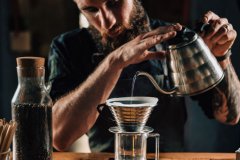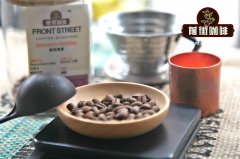Do coffee beans know the disadvantages of Robusta coffee beans? Talk about the appearance and taste of Luodou.

Professional coffee knowledge exchange more coffee bean information please follow the coffee workshop (Wechat official account cafe_style)
Rob Stasta and Arabica are the two main coffee varieties in the coffee market; coffee beans like Arabica grow at colder altitudes in the tropics, so Robusta dominates the world below 600 meters above sea level. Robusta, which focuses on refreshing, low price and insipid aroma, why use Robusta to make instant solution? don't listen to the introduction about beans.
Robstado grows in the lowlands of 200,000m above sea level, likes the warm climate, requires a temperature of 24029 ℃, and does not require high rainfall. However, there is a point that this variety depends on insects or wind to pollinate, so it takes 911 months from pollination to fruit, which is longer than Arabica. The Robusta species have long leaves, bright green leaves and a maximum height of 10 meters, but the roots are very shallow, the fruit is slightly rounder than that of Arabica, the bean body is flat and round, and the middle pit is straight.
Robusta has a unique fragrance, called Rob smell, which some people think is musty. Robusta's coffee smell is bright and strong, because its caffeine content is much higher than that of Arabica, and the coffee liquid extracted is about twice that of Arabica. This is why it is suitable for making instant coffee!
But today's Italians still drink robusta coffee, and they think Robsta is no worse than Arabica.
Colombia only grows first-class Arabica coffee beans, and now that trend has changed! The demand for robusta coffee beans in emerging markets has soared, and Costa Rica, which has always looked down on the coffee beans, has also begun to join the growing ranks.
Robusta tastes so strong that some people even describe it as "rubber tires", "oil barrels" or "children's tears".
As a result, Arabica beans now account for 65% of global coffee production. However, this trend is now changing! Global demand for robusta beans is rising, especially in Asia, prompting Latin American countries to start mass production of the relatively cheap beans.
At present, both Guadilama and Nicaragua are expanding the production areas of Robota beans. Costa Rica also lifted the ban on growing robusta beans. Even Colombia, which has always looked down on this kind of coffee beans in the past, has begun to break with tradition and start experimental planting.
Colombia used to be reluctant to produce robusta beans, mainly for fear of tarnishing the country's reputation for only high-quality coffee beans.
Important Notice :
前街咖啡 FrontStreet Coffee has moved to new addredd:
FrontStreet Coffee Address: 315,Donghua East Road,GuangZhou
Tel:020 38364473
- Prev

Five methods must be learned for hand-brewed coffee beans and water quality requirements for hand-brewed coffee
Professional coffee knowledge exchange more coffee bean information Please pay attention to the coffee workshop (Wechat official account cafe_style) there is always a kind of "your heart water" ~ when you have mastered the coffee beans and water quality requirements for hand-brewed coffee introduced in the first two articles, then you can learn the blending skills. There are many ways to brew coffee by hand, among which the following five methods are the most commonly used.
- Next

How to identify the freshness of coffee beans how to deal with fresh coffee beans
Professional coffee knowledge exchange more coffee bean information please follow the coffee workshop (Wechat official account cafe_style) 1. It is best to buy the amount you can finish within a month from the coffee roasting date, because the freshness of coffee beans is calculated from the time the coffee is roasted. Freshly roasted coffee beans will begin to exhaust (mainly carbon dioxide) for about a week, when the gas is completely exhausted.
Related
- Beginners will see the "Coffee pull flower" guide!
- What is the difference between ice blog purified milk and ordinary milk coffee?
- Why is the Philippines the largest producer of crops in Liberia?
- For coffee extraction, should the fine powder be retained?
- How does extracted espresso fill pressed powder? How much strength does it take to press the powder?
- How to make jasmine cold extract coffee? Is the jasmine + latte good?
- Will this little toy really make the coffee taste better? How does Lily Drip affect coffee extraction?
- Will the action of slapping the filter cup also affect coffee extraction?
- What's the difference between powder-to-water ratio and powder-to-liquid ratio?
- What is the Ethiopian local species? What does it have to do with Heirloom native species?

